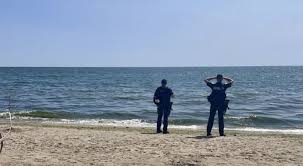Visitors to Odesa’s sun-soaked shores thought they were heading for a peaceful morning by the sea—but instead, the beach became the scene of a horrifying mystery.
Witnesses recall a sudden pair of thunderous blasts ripping through the air, leaving swimmers lifeless in the water. How could explosives have drifted into a supposedly tranquil resort zone, and why were holidaymakers even in waters marked as off-limits?
A devastating tragedy struck Ukraine’s Black Sea coast when three people were killed after explosive devices went off near swimmers at a well-known tourist beach in thTragedy on Odesa’s Shores: Explosives Claim Lives at Black Sea Beach Amid Wartime Danger
Visitors to Odesa’s sun-soaked coastline expected a tranquil day by the sea, the soothing rhythm of waves and warm sunshine offering a temporary escape from the hardships of everyday life. Instead, a peaceful morning was shattered by a devastating explosion that claimed three lives and cast a dark shadow over Ukraine’s Black Sea resort region.
What was meant to be a leisurely swim turned into a nightmare, raising urgent questions about safety, awareness, and the ongoing risks posed by war even far from the battlefield.
The Incident: Sudden Explosions in Restricted Waters
On Sunday morning at approximately 11:30 a.m., holidaymakers swimming between the popular resort towns of Karolino-Buhaz and Zatoka near Bilhorod-Dnistrovskyi were rocked by a pair of powerful blasts.
Witnesses reported hearing two thunderous explosions mere seconds apart, followed by chaos and panic as people scrambled for safety. Emergency responders rushed to the scene but tragically confirmed that two men and a woman had died instantly from their injuries sustained in the water.

Local authorities and multiple news outlets, including The Independent and Pravda, have identified the cause of the blasts as underwater explosive devices—most likely sea mines or other remnants left over from the ongoing conflict in Ukraine. These deadly artifacts, carried by currents and winds, drifted into an area that was officially designated as off-limits to swimmers due to the risk of wartime hazards.
Wartime Risks Spill into Civilian Spaces
Since the full-scale Russian invasion of Ukraine began in February 2022, the Black Sea has become a contested and dangerous body of water. Naval mines, unexploded ordnance, and other military debris have littered coastal zones, transforming once-popular beaches into perilous zones. Despite continuous efforts by Ukrainian demining teams and engineers to clear hazards and patrol the coastline, the dynamic nature of the sea and shifting weather patterns make complete safety an ongoing challenge.
Government warnings, visible signage, and local patrols have repeatedly alerted the public to the dangers of entering restricted zones along Odesa’s shores. Yet, some residents and tourists continue to disregard these advisories, whether due to a lack of awareness, underestimation of the risk, or the desire to find respite from the hardships imposed by war.
The Human Cost and Community Impact
The tragic deaths have deeply affected the local community, casting a pall over the region’s summer season. Odesa’s beaches, once vibrant hubs of tourism and relaxation, have been dramatically altered by the shadow of conflict. Families who once flocked to the coast now face a stark reality: the threat of deadly explosives lurking beneath the waves.
Local officials have expressed profound condolences to the victims’ families, acknowledging that even areas far removed from frontline combat zones are not immune to the war’s devastating impact. The loss of life serves as a heartbreaking reminder of the civilian toll in a conflict that continues to disrupt and endanger everyday life.
In response, regional authorities are reviewing measures to increase safety along the coast. Proposals include more frequent patrols, enhanced public education campaigns, stricter enforcement of beach closures, and potentially extending restricted zones. The goal is to prevent further loss of life and keep civilians away from hazardous areas.
Official Warnings and Public Responsibility
The State Emergency Service of Ukraine issued a solemn reminder to the public: “Breaking safety rules during wartime can be deadly.” This statement underscores the urgent need for vigilance, compliance, and respect for safety protocols designed to protect lives.
Tourists and locals alike face difficult choices amid the ongoing conflict—balancing the need for normalcy and leisure with the harsh realities of war. While some monitored areas remain open under strict conditions, the prevailing message from authorities is clear: the Black Sea coast remains dangerous, and any deviation from safety guidelines could have fatal consequences.
The Broader Context: War’s Reach Beyond the Battlefield
The tragedy at Odesa’s beach illustrates a painful truth about modern conflict—it extends far beyond the immediate sites of combat. Civilian spaces, natural environments, and public infrastructures become arenas of risk, sometimes years after hostilities begin.
The Black Sea, historically a place of commerce, culture, and recreation, now also serves as a somber reminder of the war’s persistent presence. Every unexploded mine and every drifting device is a latent threat, making routine activities like swimming a potentially life-threatening act.
This incident is a stark symbol of how war reshapes daily life, demanding new levels of awareness, adaptation, and caution from communities caught in its wake.
Conclusion
The explosion that claimed three lives on Odesa’s coastline is a tragic testament to the far-reaching dangers of war. Once a place of joyful leisure and respite, the Black Sea now conceals silent hazards beneath its waves—remnants of a conflict that continues to ripple through the lives of millions.
Until peace is restored, Odesa’s beaches remain perilous frontlines where vigilance can mean the difference between life and death. The hope is that this tragedy will galvanize stronger protections, greater public awareness, and a renewed commitment to safeguarding civilians from the invisible dangers that war leaves behind.
As families mourn and the community reels, the loss serves as a sobering reminder: the cost of conflict is not confined to battlefields alone but lives on in the spaces where people seek solace and normalcy.



